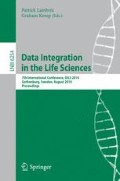Abstract
Combining information from multiple heterogeneous data sources can aid prediction of protein-protein interaction. This information can be arranged into a feature vector for classification. However, missing values in the data can impact on the prediction accuracy. Boosting has emerged as a powerful tool for feature selection and classification. Bayesian methods have traditionally been used to cope with missing data, with boosting being applied to the output of Bayesian classifiers. We explore a variation of Adaboost that deals with the missing values at the level of the boosting algorithm itself, without the need for any density estimation step. Experiments on a publicly available PPI dataset suggest this overall simpler and mathematically coherent approach may be more accurate.
Access this chapter
Tax calculation will be finalised at checkout
Purchases are for personal use only
Preview
Unable to display preview. Download preview PDF.
References
Azuaje, F., Dopazo, J.: Data Analysis and Visualization in Genomics and Proteomics. John Wiley & Sons, Chichester (2005)
Bauer, E., Kohavi, R.: An empirical comparison of voting classification algorithms: bagging, boosting, and variants. Machine Learning 36(1-2), 105–139 (1999)
Ben-Hur, A., Noble, W.S.: Kernel methods for predicting protein-protein interactions. Bioinformatics 21(Suppl. 1), i38–i46 (2005)
Bork, P., Jensen, L.J., von Mering, C., Ramani, A.K., Lee, I., Marcotte, E.M.: Protein interaction networks from yeast to human. Curr. Opin. Struct. Biol. 14(3), 292–299 (2004)
Breitkreutz, B.J., Stark, C., Reguly, T., Boucher, L., Breitkreutz, A., Livstone, M., Oughtred, R., Lackner, D.H., Bhler, J., Wood, V., Dolinski, K., Tyers, M.: The bioGRID interaction database: 2008 update. Nucleic Acids Res. 36(Database issue), D637–D640 (2008)
Deane, C.M., Salwiski, L., Xenarios, I., Eisenberg, D.: Protein interactions: two methods for assessment of the reliability of high throughput observations. Mol. Cell. Proteomics 1(5), 349–356 (2002)
Edwards, A.M., Kus, B., Jansen, R., Greenbaum, D., Greenblatt, J., Gerstein, M.: Bridging structural biology and genomics: assessing protein interaction data with known complexes. Trends Genet. 18(10), 529–536 (2002)
Freund, Y., Schapire, R.: A decision-theoretic generalization of on-line learning and an application to boosting. Journal of Computer and System Science 55(1) (1997)
Hastie, T., Tibshirani, R., Friedman, J.H.: The Elements of Statistical Learning. Springer, Heidelberg (2001)
Jansen, R., Greenbaum, D., Gerstein, M.: Relating whole-genome expression data with protein-protein interactions. Genome Res. 12(1), 37–46 (2002)
Jansen, R., Yu, H., Greenbaum, D., Kluger, Y., Krogan, N.J., Chung, S., Emili, A., Snyder, M., Greenblatt, J.F., Gerstein, M.: A Bayesian networks approach for predicting protein-protein interactions from genomic data. Science 302(5644), 449–453 (2003)
Kerrien, S., Alam-Faruque, Y., Aranda, B., Bancarz, I., Bridge, A., Derow, C., Dimmer, E., Feuermann, M., Friedrichsen, A., Huntley, R., Kohler, C., Khadake, J., Leroy, C., Liban, A., Lieftink, C., Montecchi-Palazzi, L., Orchard, S., Risse, J., Robbe, K., Roechert, B., Thorneycroft, D., Zhang, Y., Apweiler, R., Hermjakob, H.: Intact–open source resource for molecular interaction data. Nucleic Acids Res. 35(Database issue), D561–D565 (2007)
Lin, M., Hu, B., Chen, L., Sun, P., Fan, Y., Wu, P., Chen, X.: Computational identification of potential molecular interactions in Arabidopsis. Plant Physiol. 151(1), 34–46 (2009)
Lin, N., Wu, B., Jansen, R., Gerstein, M., Zhao, H.: Information assessment on predicting protein-protein interactions. BMC Bioinformatics 5, 154 (2004)
Lu, L.J., Xia, Y., Paccanaro, A., Yu, H., Gerstein, M.: Assessing the limits of genomic data integration for predicting protein networks. Genome Res. 15(7), 945–953 (2005)
Malacaria, P., Smeraldi, F.: On Adaboost and optimal betting strategies. In: Proceedings of the 5th international conference on data mining (dmin/worldcomp), July 2009, pp. 326–332. CSREA Press (2009)
von Mering, C., Krause, R., Snel, B., Cornell, M., Oliver, S.G., Fields, S., Bork, P.: Comparative assessment of large-scale data sets of protein-protein interactions. Nature 417(6887), 399–403 (2002)
Michalski, R.S., Carbonell, J.G., Mitchell, T.M.: Machine Learning: An Artificial Intelligence Approach. Tioga Publishing Company (1983)
Najafabadi, H.S., Salavati, R.: Sequence–based prediction of protein–protein interaction by means of codon usage. Genome Biology 9(5) (2008)
Pelckmans, K., Brabanter, J.D., Suykens, J.A.K., Moor, B.D.: Handling missing values in support vector machine classifiers. Neural Networks 18, 684–692 (2005)
Rätsch, G., Warmuth, M.: Efficient margin maximizing with boosting. Journal of Machine Learning Research 6, 2131–2152 (2005)
Rudin, C., Schapire, R.E., Daubechies, I.: On the dynamics of boosting. In: Advances in Neural Information Processing Systems, vol. 16 (2004)
Schapire, R., Singer, Y.: Improved boosting algorithms using confidence-rated predictions. Machine Learning 37(3) (1999)
Scott, M.S., Barton, G.J.: Probabilistic prediction and ranking of human protein-protein interactions. BMC Bioinformatics 8, 239 (2007)
Shen, J., Zhang, J., Luo, X., Zhu, W., Yu, K., Chen, K., Li, Y., Jiang, H.: Predicting protein-protein interactions based only on sequences information. Proc. Natl. Acad. Sci. U.S.A. 104(11), 4337–4341 (2007)
Vapnik, V.N.: The nature of statistical learning theory. Springer, Heidelberg (1995)
Author information
Authors and Affiliations
Editor information
Editors and Affiliations
Rights and permissions
Copyright information
© 2010 Springer-Verlag Berlin Heidelberg
About this paper
Cite this paper
Smeraldi, F., Defoin-Platel, M., Saqi, M. (2010). Handling Missing Features with Boosting Algorithms for Protein–Protein Interaction Prediction. In: Lambrix, P., Kemp, G. (eds) Data Integration in the Life Sciences. DILS 2010. Lecture Notes in Computer Science(), vol 6254. Springer, Berlin, Heidelberg. https://doi.org/10.1007/978-3-642-15120-0_11
Download citation
DOI: https://doi.org/10.1007/978-3-642-15120-0_11
Publisher Name: Springer, Berlin, Heidelberg
Print ISBN: 978-3-642-15119-4
Online ISBN: 978-3-642-15120-0
eBook Packages: Computer ScienceComputer Science (R0)

